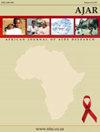斯威士兰一项全国性调查结果显示,在普遍性高流行环境中,青年人中与艾滋病毒检测相关的因素
IF 1.1
4区 医学
Q4 PUBLIC, ENVIRONMENTAL & OCCUPATIONAL HEALTH
引用次数: 0
摘要
目的:尽管斯瓦蒂尼是非洲第一个在全国艾滋病毒感染者中实现联合国艾滋病规划署95-95-95目标的国家,但15-24岁的年轻人在艾滋病毒检测方面落后了。本研究确定了青少年中艾滋病毒检测的总体流行率以及与艾滋病毒检测相关的因素。方法:采用多变量logistic回归分析2016-2017年斯威士兰艾滋病发病率测量调查(SHIMS2)中1834名年轻人的数据。结果:总体而言,66%的年轻人在SHIMS2之前的12个月内进行了艾滋病毒检测。在男性、15-17岁人群、未婚/同居人群、接受过小学和中学教育的人群以及对艾滋病毒感染者和艾滋病患者有高度耻辱感的人群中,检测艾滋病毒的几率较低。与富裕家庭的年轻人相比,来自贫困和中等家庭的年轻人接受艾滋病毒检测的几率更高。结论:增加艾滋病毒检测的努力应考虑社会人口和行为因素,这些因素被确定为该年龄组未进行艾滋病毒检测的决定因素。本文章由计算机程序翻译,如有差异,请以英文原文为准。
Factors associated with HIV testing among youth in a generalised hyperendemic setting: findings from a national survey in Eswatini
Aim: Even though Eswatini was the first country in Africa to achieve the UNAIDS 95-95-95 targets among people living with HIV nationally, youth aged 15–24 years lag behind in HIV testing. This study determined the overall prevalence of HIV testing among the youth and the factors associated with HIV testing. Methods: Data were analysed for 1 834 young people from the 2016–2017 Swaziland HIV Incidence Measurement Survey (SHIMS2) using multivariable logistic regression. Results: Overall, 66% of the young people had tested for HIV in the past 12 months before SHIMS2. Lower odds of HIV testing were observed among males, among those aged 15–17 years, the never married/cohabited, those with primary and secondary education, and among those who had high perceived stigma towards people living with HIV and AIDS. Youth from households classified in the poor and middle quintiles had higher odds of testing for HIV compared to those from rich households. Conclusion: Efforts to increase HIV testing should consider the sociodemographic and behavioural factors identified as determinants of HIV non-testing in this age group.
求助全文
通过发布文献求助,成功后即可免费获取论文全文。
去求助
来源期刊

Ajar-African Journal of Aids Research
医学-公共卫生、环境卫生与职业卫生
CiteScore
1.80
自引率
8.30%
发文量
38
审稿时长
>12 weeks
期刊介绍:
African Journal of AIDS Research (AJAR) is a peer-reviewed research journal publishing papers that make an original contribution to the understanding of social dimensions of HIV/AIDS in African contexts. AJAR includes articles from, amongst others, the disciplines of sociology, demography, epidemiology, social geography, economics, psychology, anthropology, philosophy, health communication, media, cultural studies, public health, education, nursing science and social work. Papers relating to impact, care, prevention and social planning, as well as articles covering social theory and the history and politics of HIV/AIDS, will be considered for publication.
 求助内容:
求助内容: 应助结果提醒方式:
应助结果提醒方式:


